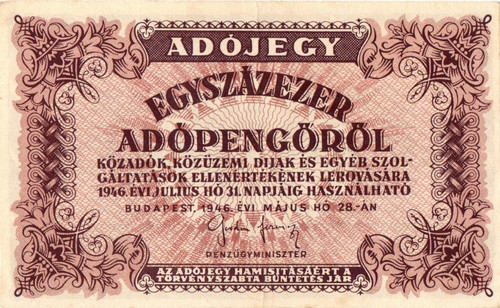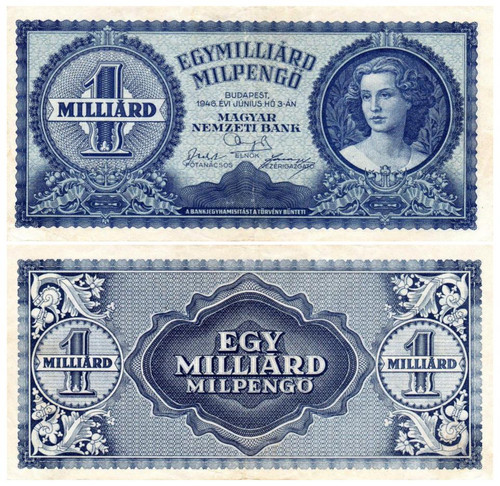1946 Hungary 10,000 Adopengo (1 Sextillion Pengo) P-143 Used XF
Description:
The 1946 Hungary 10,000 Adopengo banknote, cataloged as P-143, is a remarkable artifact from one of the most extreme periods of hyperinflation in history. Equal to 1 sextillion pengo, this note represents the astronomical inflation rates that plagued post-World War II Hungary. Graded as Used XF (Extra Fine) quality, it retains much of its historical and visual appeal despite being circulated.
Design and Features:
-
Obverse: The front of the note features a sophisticated and intricate design typical of the era, with detailed patterns and ornate borders. Central to the design is the denomination "10,000 Adopengo," prominently displayed to indicate its value. The craftsmanship and complexity of the patterns reflect the efforts to maintain trust in the currency despite the rampant inflation.
-
Reverse: The reverse side of the note continues the intricate design theme, often showcasing geometric patterns and elaborate engravings that add to the note's aesthetic appeal. The denomination is again prominently featured, ensuring clarity and recognition of its high value.
Security Features: Given the period's technological constraints and the urgency of production, security features were minimal compared to modern standards. However, the detailed engravings and intricate patterns served as a deterrent against counterfeiting.
Historical Significance: Issued in 1946, this banknote is a poignant reminder of the hyperinflation that crippled Hungary's economy following World War II. The 10,000 Adopengo note, equivalent to 1 sextillion pengo, underscores the severity of the economic crisis. This period is marked by the issuance of increasingly higher denominations as the value of the currency plummeted, culminating in the introduction of the Adopengo as a temporary solution to stabilize the economy.
Collector's Value: Graded as Used XF (Extra Fine), this banknote is in remarkable condition given its historical context. The XF grade indicates that the note has been circulated but retains sharp details, vibrant colors, and minimal signs of wear. Its historical significance and relatively high preservation make it a valuable addition to collections focused on hyperinflationary currencies, European monetary history, or post-war economic crises.
































